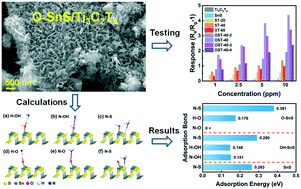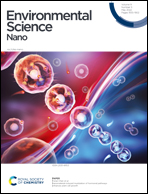Synergistic enhanced NH3-sensing of SnS via Ti3C2Tx-oriented vertical growth and oxygen-containing functional group regulation†
Abstract
Stannous sulfide (SnS) is a promising candidate for gas sensing applications due to its unique two-dimensional (2D) puckered monolayer and response capability at room temperature (25 °C). However, the general stacking of 2D nanoflakes as well as the characteristic of poor conductivity of SnS suppresses its response capability towards rarefied gas detection. Here, we report a nanocomposite of SnS/Ti3C2Tx, featured by the vertically aligned, discrete SnS nanoflakes grown on the surface of Ti3C2Tx. The SnS/Ti3C2Tx nanocomposite with unique loose architecture and modulated conductivity was achieved via a one-step solvothermal process with Ti3C2Tx induction. Further boosting of the sensitivity towards trace NH3 was realized by functionalizing the surface of SnS with precise alkaline treatment. The oxygen-containing functional groups on the surface of SnS, introduced during alkaline treatment, serve as catalytic medium to activate S atoms for NH3 adsorption enhancement, which was clarified by first-principles calculations. The obtained nanocomposite achieved a significant promotion of response by 27.5 times that of pure SnS towards 5 ppm NH3 at 25 °C. It also exhibits a practical capability to sense rarefied NH3 as low as 250 ppb with a response of 0.453. The accomplishments light a new way for the research of microstructure construction and ultra-low concentration gas detection of black phosphorus-like materials.

- This article is part of the themed collections: Nano-bio interactions and Best Papers 2022 – Environmental Science: Nano


 Please wait while we load your content...
Please wait while we load your content...